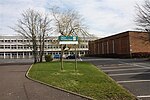Eastwood, Strathclyde
Civil parishes of ScotlandClarkston, East RenfrewshireDistricts of ScotlandEast RenfrewshireGiffnock ... and 3 more
History of RenfrewshireNewton MearnsWest of Scotland geography stubs

Eastwood (Scottish Gaelic: A' Choille an Ear, Scots: Eastwid) is a civil parish which straddles Glasgow and East Renfrewshire in Scotland. The parish has had no administrative functions since 1930, but is still used for some statistical purposes. From 1975 until 1996 the name was also used for a local government district in the Strathclyde region. The district covered the part of Eastwood parish outside the city of Glasgow plus adjoining areas to the south. The district was abolished in 1996 to become part of East Renfrewshire.
Excerpt from the Wikipedia article Eastwood, Strathclyde (License: CC BY-SA 3.0, Authors, Images).Eastwood, Strathclyde
Geographical coordinates (GPS) Address Nearby Places Show on map
Geographical coordinates (GPS)
| Latitude | Longitude |
|---|---|
| N 55.807 ° | E -4.295 ° |
Address
G46 7QB , Orchard Park
Scotland, United Kingdom
Open on Google Maps








